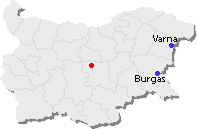
The Tomb is located in the northern part of Kazanlak town in the Tjulbeto park.
That is the first Bulgarian tourist sight included in the UNESCO lists.
The Kazanlak tomb is a UNESCO monument since 1979. It was discovered incidentally in the late 1944 year. The archeologists date it back to the end of the IV C. and the beginning of the III C. BC.
From architectural point of view the Kazanlak tomb can be described as a unique construction of the time. It was built in the ground, positioned from north to south and the Tomb’s top was made level identical to the surrounding site.
The Tomb is world famous for its incredible wall-paintings. They were described very often as masterpieces of the ancient Thracian art. Despite the scarce artifacts, the Kazanlak tomb deserve to be accepted as one of the greatest historical discoveries found on our lands only because of those wall-paintings.
The original tomb is engraved today and a copy, open for visitors, was constructed few meters from it.
The copy-tomb consists of three halls – a porch made of stones and clay, a narrow corridor made of bricks and a burial chamber with a bell-shaped cupola also made of bricks.
The construction of the tomb itself was ordered by the ruler Roygos, son of Seuthus III.
Most impressive are the wall-paintings in the corridor and the burial chamber. They are extremely beautiful and tell us much of the skills of the ancient Thracian painters.
Painters used four colors – white, yellow, red and black where the paints were of mineral composition. The frieze depict floral motifs and military scenes.
The remains of a man and a woman were discovered in the burial chamber, presumably that were local owners. The paintings in the chamber where a man and a woman, decorated with gold are depicted testify of that.
Some ceramic ritual utensils as well as few parts of gold decorations were discovered in the mound.













